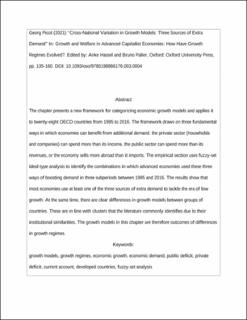| dc.contributor.author | Picot, Georg Johannes | |
| dc.date.accessioned | 2022-03-22T11:50:50Z | |
| dc.date.available | 2022-03-22T11:50:50Z | |
| dc.date.created | 2021-01-30T20:55:04Z | |
| dc.date.issued | 2021 | |
| dc.identifier.isbn | 9780198866176 | |
| dc.identifier.uri | https://hdl.handle.net/11250/2986784 | |
| dc.description.abstract | The chapter presents a new framework for categorizing economic growth models and applies it to twenty-eight OECD countries from 1995 to 2016. The framework draws on three fundamental ways in which economies can benefit from additional demand: the private sector (households and companies) can spend more than its income, the public sector can spend more than its revenues, or the economy sells more abroad than it imports. The empirical section uses fuzzy-set ideal type analysis to identify the combinations in which advanced economies used these three ways of boosting demand in three subperiods between 1995 and 2016. The results show that most economies use at least one of the three sources of extra demand to tackle the era of low growth. At the same time, there are clear differences in growth models between groups of countries. These are in line with clusters that the literature commonly identifies due to their institutional similarities. The growth models in this chapter are therefore outcomes of differences in growth regimes. | en_US |
| dc.language.iso | eng | en_US |
| dc.publisher | Oxford University Press | en_US |
| dc.relation.ispartof | Growth and Welfare in Advanced Capitalist Economies. How Have Growth Regimes Evolved? | |
| dc.title | Cross-national variation in growth models: Three sources of extra demand | en_US |
| dc.type | Chapter | en_US |
| dc.description.version | acceptedVersion | en_US |
| dc.rights.holder | Copyright 2021 Oxford University Press | en_US |
| cristin.ispublished | true | |
| cristin.fulltext | postprint | |
| cristin.qualitycode | 2 | |
| dc.identifier.doi | 10.1093/oso/9780198866176.001.0001 | |
| dc.identifier.cristin | 1883460 | |
| dc.source.pagenumber | 135-160 | en_US |
| dc.identifier.citation | In: Growth and Welfare in Advanced Capitalist Economies: How Have Growth Regimes Evolved?. Edited by: Anke Hassel and Bruno Palier, Oxford: Oxford University Press, pp. 135-160 | en_US |
